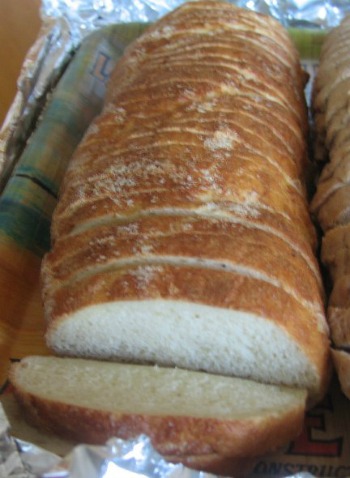Lavender Hazelnut Bread is unique and so wonderful tasting. I have been on a lavender kick lately and have been experimenting using lavender in my cooking. So easy to make using your bread machine.
Please check out my article on Cooking with Culinary Lavender which also includes my favorite recipes using lavender.
Check out Linda’s Bread Making Hints: Secrets to using the bread machine, About yeast in bread making, Sourdough Starter, and Quick Breads.
- 1 1/4 cups warm water (110 degrees F.)
- 1 tablespoon olive oil
- 1 1/2 tablespoons honey
- 1 tablespoon lavender flowers, fresh and coarsely chopped, or 3/4 tablespoons dried lavender flowers
- 1 1/2 teaspoons salt
- 1/2 cup hazelnuts, coarsely chopped*
- 3 1/4 cups bread flour or unbleached all-purpose flour
- 3 teaspoons instant yeast
- Cornmeal (optional for dusting pan)
-
Bread Machine Instructions:
-
Add all the ingredients in the bread pan of bread machine. Process according to manufacturer's instructions for a dough setting. Do not be afraid to open the lid and check the dough. It should form a nice elastic ball. If you think the dough is too moist, add additional flour (a tablespoon at a time). The same is true if the dough is looking dry and gnarly. Add warm water (a tablespoon at a time).
-
If you can not judge your dough by looking, stick your finger in and feel the dough. It should be slightly tacky to the touch. When the bread machine has completed the dough cycle, remove the dough from the pan to a lightly floured surface. Knead the dough several times and form the dough into an oval; cover with plastic wrap and let rest for 10 to 15 minutes.
-
Stand Up Mixer Instructions:
-
In a large bowl or in the bowl of a 5-quart stand mixer, add all the ingredients. Using a dough hook, mix all the ingredients together into a uniform dough. It should form a nice elastic ball. If you think the dough is too moist, add additional flour (a tablespoon at a time). The same is true if the dough is looking dry and gnarly. Add warm water (a tablespoon at a time).
-
Turn the dough out onto a floured surface and knead until elastic, about 15 minutes. In an electric mixer, it should take about 9 minutes. Cover the bowl with plastic wrap and let rest for 10 to 15 minutes.
-
After resting, turn dough bottom side up and press to flatten. For baguettes (long, slender) or boules (round), divide the dough into 2 pieces and shape. For baguettes, fold dough into an envelope by folding the top 1/3 of the way to the bottom. Then fold the bottom a 1/3 of the way over the top. Then press dough with the palm of your hand to make an indentation down the center of the dough and fold the top completely to the bottom, sealing the seam with the palm of your hand.
-
Place on a baking sheet dusted with cornmeal or covered with a silpad. Cover with plastic wrap and place in a warm spot to rise until the dough is doubled in bulk, approximately 30 to 50 minutes (depending on how warm your room is).
-
Oven Rising: Sometimes I use my oven for the rising. Turn the oven on for a minute or so, then turn it off again. This will warm the oven and make it a great environment for rising bread. If you can't comfortably press your hand against the inside of the oven door, the oven is too hot. Let it stand open to cool a bit.
-
Cool or Refrigerator Rise: If I don't have the time to wait for the rise to finish or I know that I will be interrupted before the completed rise, I do a cool rise. A cool rise is when the dough is place in the refrigerator and left to rise slowly over night approximately 8 to 12 hours. I usually do this after the first rise and the dough has been shaped into a loaf.
-
Preheat oven to 400 degrees F. After rising, slash or score the loaves with a very sharp knife making three 1/2-inch deep diagonal slashes. Bake for 20 minutes or until nicely browned. A good check is to use an instant digital thermometer to test your bread. The internal temperature should be between 200 and 210 degrees F. Remove from oven and place the loaves on a wire rack until cooled.
-
Makes a 1 1/2-pound loaf.
* You may substitute any nuts of your choice.
 I get many readers asking what cooking/meat thermometer that I prefer and use in my cooking and baking. I, personally, use the Thermapen Thermometer. Originally designed for professional use, the Super-Fast Thermapen Thermometer is used by chefs all over the world. I only endorse a few products, on my web site, that I like and use regularly.
I get many readers asking what cooking/meat thermometer that I prefer and use in my cooking and baking. I, personally, use the Thermapen Thermometer. Originally designed for professional use, the Super-Fast Thermapen Thermometer is used by chefs all over the world. I only endorse a few products, on my web site, that I like and use regularly.
You can learn more or buy yours at: Super-Fast Thermapen Thermometer.

